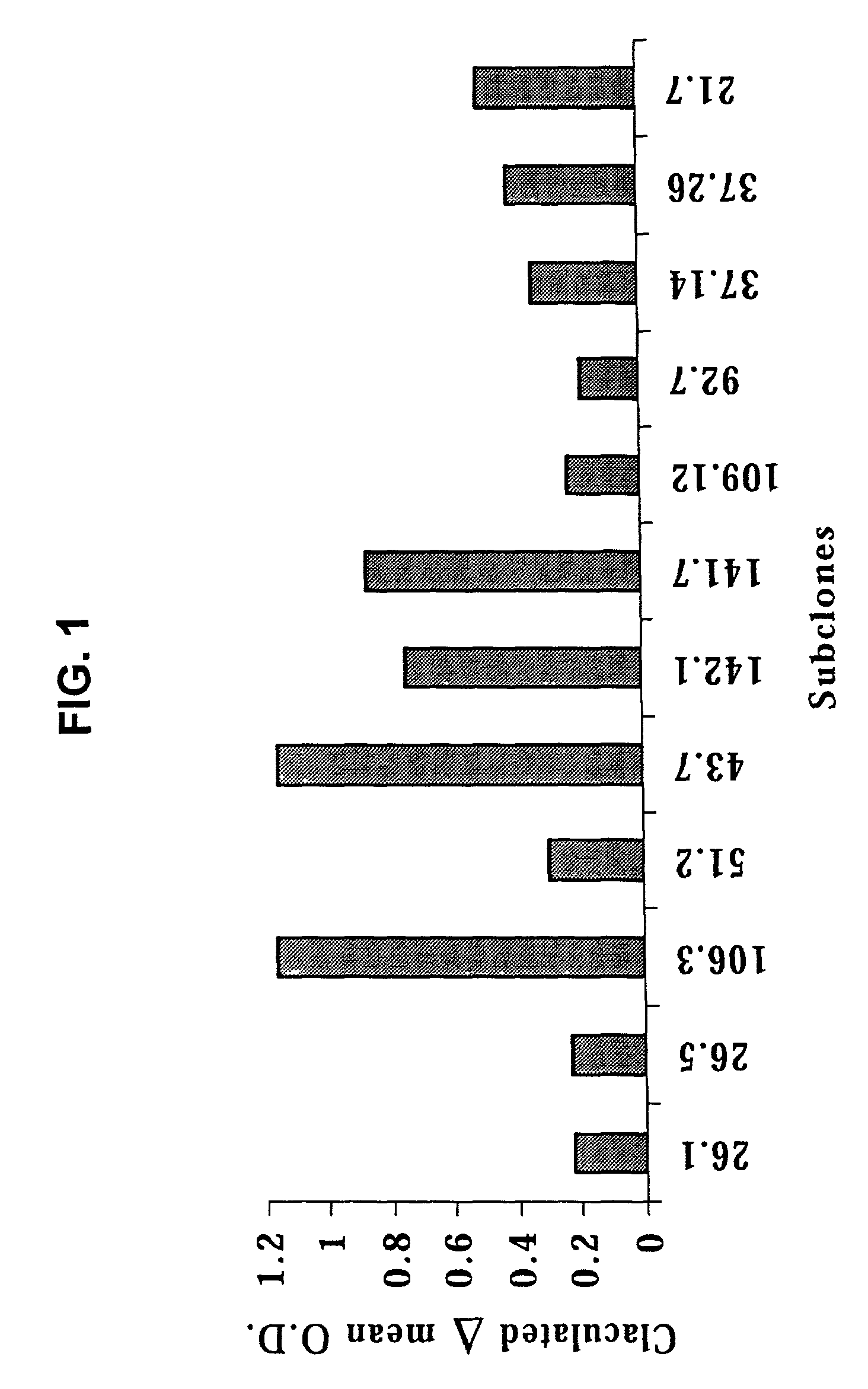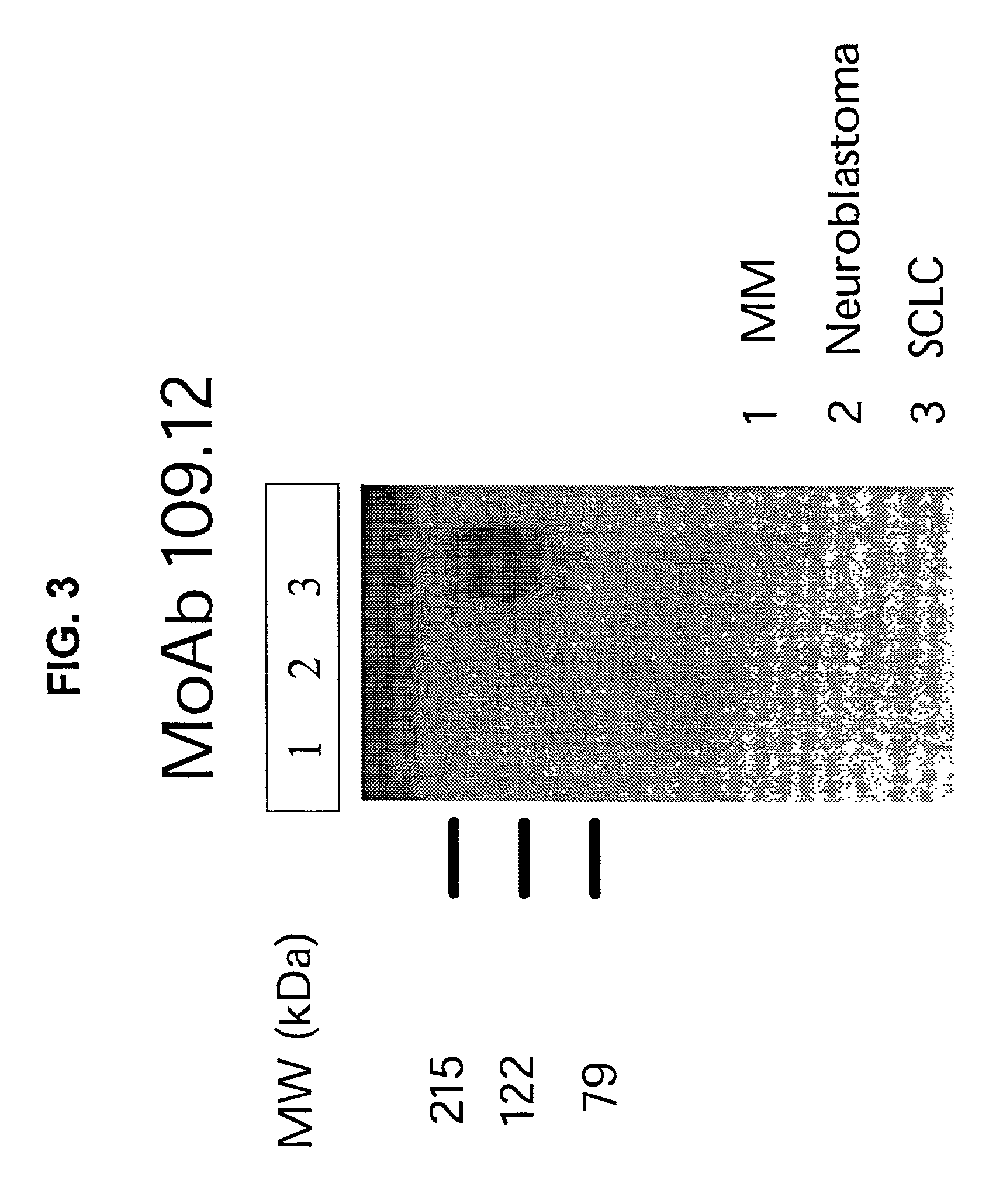Monoclonal antibodies and cell surface antigens for the detection and treatment of small cell lung cancer (SCLC)
a lung cancer and monoclonal antibody technology, applied in the field of monoclonal antibodies and cell surface antigens for the detection and treatment of small cell lung cancer, can solve the problems of tumor markers, neuron-specific enolase (nse), creatinin kinase bb, etc., and achieve the effect of low cure rate and low specificity and sensitivity
- Summary
- Abstract
- Description
- Claims
- Application Information
AI Technical Summary
Benefits of technology
Problems solved by technology
Method used
Image
Examples
example 1
Materials And Methods
Sources of Cells:
[0123]Cells and cell lines utilized and evaluated in the experiments described were purchased from the American Type Culture Collection (ATCC), 10801 University Boulevard, Manassas, Va. 20110-2209. Specifically, the cell lines include human SCLC cell lines, i.e., DMS114 (ATCC No. CRL-2066), NCI-H209 (ATCC No. HTB-172), NCI-H510A (ATCC No. HTB-184); neuroendocrine cell lines, i.e., SK-N-AS (ATCC No. CRL-2137), Be(2)- / M17 (ATCC No. CRL-2267), MC-IXC (ATCC No. CRL-2270); LnCap (prostate cancer cell line, ATCC No. CRL-1740); Caski (cervical cancer cell line, ATCC No. 1550); Namalwa (EBV-transformed tumor cell line, ATCC No. CRL-1432); HT (ATCC No. CRL-2260); IM9 (ATCC No. CCL-159); human myeloma cell lines (U266, OPM, RPMI-1860, KR12 and NCI H929); neuroblastoma cell line (NCI H2106); and the chronic myelogenous leukemic cell line K562 (ATCC No. CCL-243). Fresh clinical specimens such as breast cancer, liver carcinoma, ovarian cancer, cervical cance...
example 2
Positive Hybridomas Produce Monoclonal Antibodies that Specifically Bind to SCLC
[0135]B cell hybridomas established from immunized mice as described in Example 1 were screened by cellular ELISA with a pool of human SCLC cell lines (i.e., DMS 114, NCI-H209, NCI-H510A) compared with a pool of human neuroendocrine cell lines (SK-N-AS, MC-IXC, Be (2)-M17). Eleven hybridomas out of a pool of 170 were selected based on their production of monoclonal antibodies having the ability to specifically bind to SCLC. Limiting dilution cultures (1 cell per well) were set in up in order to establish clonal B cell hybridomas. The resultant sub-clones were screened as described above. Twelve representative sub-clones exhibiting the highest mean values for absorbance against the SCLC cells were selected for further testing. Values were adjusted by subtracting the mean O.D. of the neuroendocrine cells from the SCLC cells (FIG. 1). The selected monoclonal antibody-producing B cell hybridomas were isotype...
example 3
MoAbs React with Antigens Present in the Cell Membranes of SCLC
[0136]The selected panel of monoclonal antibodies was tested by FACS for staining of SCLC cells compared with control (neuroendocrine or multiple myeloma) cell lines. Four MoAbs, 26.1, 141.7, 92.7, and 37.14, exhibited a stronger staining of SCLC cells, when compared with the control cell lines. Western blotting performed under reducing conditions was used to further elucidate the specificity of the selected MoAbs. MoAbs 51.2 and 109.12 detected an antigen with a MW of about 200 KDa in the lanes containing the pool of SCLC cell lines (DMS114, NCI-H209, and NCI-H510A), (FIGS. 2 and 3). The appearance of a single fuzzy band indicates that the molecule recognized by the MoAbs is a single chain glycoprotein.
[0137]The control cell membrane preparations isolated from a pool of neuroendocrine (SK-N-AS, MC-IXC, and Be (2)-M17) and multiple myeloma (RPMI 8226 and U266) cell lines, respectively, were not stained by the MoAb 109.12...
PUM
 Login to View More
Login to View More Abstract
Description
Claims
Application Information
 Login to View More
Login to View More - R&D
- Intellectual Property
- Life Sciences
- Materials
- Tech Scout
- Unparalleled Data Quality
- Higher Quality Content
- 60% Fewer Hallucinations
Browse by: Latest US Patents, China's latest patents, Technical Efficacy Thesaurus, Application Domain, Technology Topic, Popular Technical Reports.
© 2025 PatSnap. All rights reserved.Legal|Privacy policy|Modern Slavery Act Transparency Statement|Sitemap|About US| Contact US: help@patsnap.com



